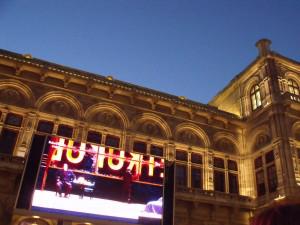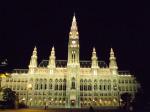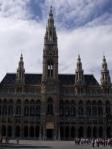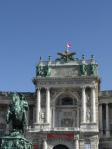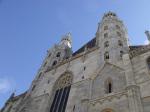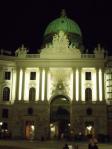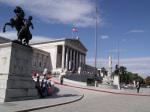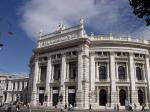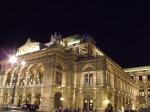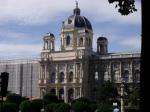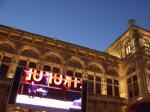Walking across the tarmac was like entering another world. The sun was beating down, the people were friendly and there was that fabled gate at the border: ‘EU Passports’. No inquisitions as to my intentions, just hold the photo page up to the glass and wait for the nod. Through in about two minutes. Welcome back to the EU, you’re now in Wien.
Wien is, as I’m sure one or two smartarses will know, the German for Vienna. A city famed for its buildings, history, cake and beer, and my home for a week.
The easiest way to show me the city’s sights, my friend (and one-time flat mate, who now lives and teaches in Vienna) decided, was to go on a walking tour – not with one of those annoyingly large groups of tourists that seem to dominate the city centre, but by ourselves (with the occasional soundbite from an out of date Lonely Planet guide book). Vienna is not a big city, in fact it’s hard to believe it’s home to over one and a half million people. The basic layout is simple: 23 districts over three zones: The historic centre is district and zone 1; districts 2-9 make up second zone, ringed around the first; and the others populate the outer zone. The only other defining things are the ring of hills from east round the south to the west of the city (or west to east, if you so prefer) and the Danube – it isn’t at all blue, no matter with Strauss says – which cuts through the north east.
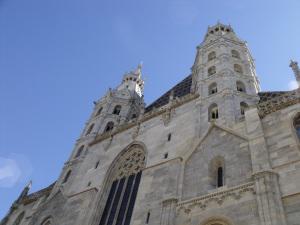
Stephansplatz seemed as good as anywhere to start out tour, so we emerged from the metro (and a very nice metro it is too) into the sunshine and then straight away into the shadow of Stephansdom, one of the tallest churches in the world. After surprising a few people dressed as Mozart to sell concert tickets by replying in German (‘No thank you’ I can stretch to) we ditched some of the tourists to amble through the side streets and look at the beautiful buildings that line almost every street of the first district.
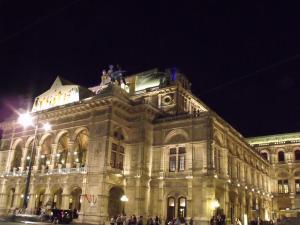
The first major stop on our tour was the Vienna Opera House. As opera houses go, this one is up there; famed for its connections with classical music Vienna draws in classical music fans from around the globe and the opera house is a pilgrimage site for many. Impressive in the daytime this building really comes alive at night when it is illuminated against the early-setting sun, its arches and cloisters are a familiar site to many who pass it every day on the Ringstraße[Ring Street]. More famous than the building they perform in is the company that share this building’s famous name:
Wienner Staatsoper, or Vienna State Opera. The company originated as the Vienna Court Opera, but changed its name to what we know it as today when the Hapsburg monarchy ended in 1920. Today they perform seasons of operas and concerts, both in Vienna and around the world. As if that weren’t enough, the members of the world famous Vienna Philharmonic come exclusively from the company. Continuing the illusion of being a cultured sort of person (having been to the ballet in
Moscow) I decided to partake in a little opera. Arabella (by Richard Strauss) was on my third night there, so I opted for that. My bank will probably be glad to hear that during the summer performances are screened live outside for you to watch at your leisure and for free. The only slight drawback, of course, is that it is an Austrian opera and thus in German. I’m sure my linguistic limitations are fairly obvious by now (I did French at school, not so handy here, nor my Spanish), but I got the gist – sort of – and enjoyed the music.
The next stop on the Ringstraße was the garden flanked on either side by the enormous and identical Kunsthistorisches Museum and Naturhistorisches Museum – the art history
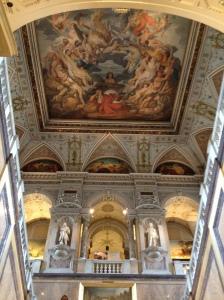
(or fine art) and natural history museums. Opened in the 1890s these two mirror images were built on order of the emperor in order to hold the vast collections of the Hapsburg dynasty, in order for them to be on show to the public. I can’t say anything for the Kunsthistorisches as I didn’t step foot in it; however, I can tell you that the Naturhistorisches is spectacular. With an enormous marble entrance hall with some of sciences most notable figures immortalised in marble and enormous frescos depicting science in all its glory it’s hard to remember that there’s enormous numbers of specimens to look at. Remarkably there are also several halls that have been translated so us non-German speakers can enjoy them. The other halls, however, I had to go by the binomial Latin – who said that biology degree would never come in handy?
With its flowing Greek columns and Greco-Roman-esque adornments the shimmering white building of the Austrian parliament is slightly further along the ring. With it’s entrance above street level, a lofty semi-circular ramp leads up and through the columns. When we passed it was covered with a long red carpet, apparently for the parade of classic cars that were going up it to be shown off. And no, I’ve absolutely no idea what was going on beyond that.
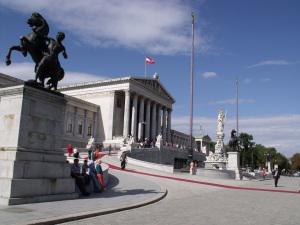
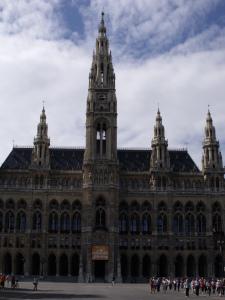
The political theme doesn’t end here, as the next stop on the ring is the two buildings that face each other across the road. On the inside of the ring is the green-domed Volkstheatre, or the People’s Theatre – originally built on request of the people of Vienna to bring drama and literature to the masses. To this day it follows the founding principals that it is to perform lots of new works alongside the classics. Set behind a park on the outer side of the ring is the Rathaus, the Viennese town hall. Built to resemble the government buildings of Flanders, Belgium, its many gothic towers pointing up towards the sky. I’m also reliably informed that it plays host to “Vienna’s most kitschy Christmas market”, although unsurprisingly it wasn’t there in September.
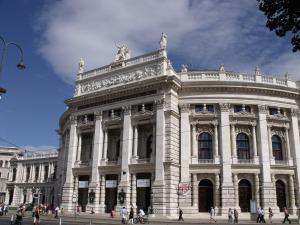

It’ll be obvious to anyone that knows Vienna that I have missed out the Hofburg on this trip round the Ringstraße. This would be like describing London and ignoring the Thames. Home to the 600 years of the Hapsburg Dynasty the Hofburg has been the seat of governance of several countries, empires and republics dating back to the early 13
th century. It’s a bit of a hotch-potch really, as successive generations of Hapsburgs tried to make their mark on this vast section of central Vienna, resulting in a melting pot of architectural styles, each trying to out-compete one another in terms of grandness. It was also playing host to a harvest festival the first few days I was in Vienna – as far as I could tell, they appeared to be incredibly grateful for beer and … to have forgotten about the rest in a hop-induced haze. We might have stayed here a while…
And somehow I have yet got to the end of the Vienna post and only got halfway through! Only one palace and the most fleeting of references to beer will just not do. Tomorrow there will be more palaces, much more beer, Schnitzel, cake and wine. Let’s be honest, the last four are clearly the most important!
-
-
-
-
-
-
-
-
-
-
-
-
Cr


